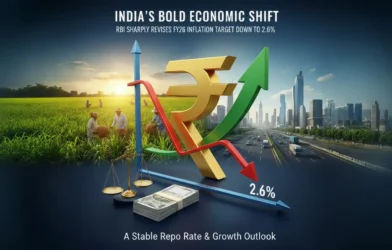Mumbai, October 03, 2025 — In a significant move to deepen participation in India’s capital markets and enhance liquidity, the Reserve Bank of India (RBI) has revised financing limits for equity-related borrowings. The central bank has raised the financing cap for IPO Financing from ₹10 lakh to ₹25 lakh per individual and increased the ceiling on Loans Against Shares (LAS) from ₹20 lakh to ₹1 crore.
The decision, announced by RBI Governor Sanjay Malhotra, marks the first major revision of share-backed lending in decades and is expected to encourage greater participation by high-net-worth individuals (HNIs), institutional investors, and market intermediaries.
Updating Old Norms for a Growing Market
IPO financing and loans against shares are not new to Indian capital markets, but the limits had remained unchanged for years. “Loans against shares and IPO financing existed earlier, but were not revised for many years. It is only natural that these limits be updated,” Governor Malhotra said.
The last revision of the LAS limit was carried out in 1998. In light of the inflation and exponential growth of Indian capital markets over the past 25 years, the RBI noted that the previous ceilings had become outdated. The new thresholds are designed to reflect the changing scale of investments and the rising appetite of investors in India’s booming equity market.
Expanding Participation in IPOs
The timing of the move is crucial. India’s primary market activity has been buzzing in recent months, with several blockbuster IPOs lined up. Reliance Jio, Tata Capital, and LG Electronics are among the big-ticket companies expected to hit the markets this year.
With higher limits for IPO financing subscriptions, analysts believe the HNIs category of investors—a segment that often bids aggressively in large IPOs—will benefit significantly. By allowing individual investors to access up to ₹25 lakh in financing, the RBI has effectively expanded the potential for robust oversubscription in upcoming public offers. This could improve overall liquidity and investor sentiment in the markets.
Broader Coverage Beyond Equities
The RBI also clarified that the enhanced lending limits would extend beyond equities to include units of Real Estate Investment Trusts (REITs) and Infrastructure Investment Trusts (InvITs). Both asset classes have gained traction among investors seeking exposure to India’s infrastructure and real estate growth story.
By raising financing limits for these vehicles, the RBI has broadened the scope for investors to participate in alternative investment avenues, boosting capital flow into sectors critical for India’s long-term growth.
Removing Ceilings on Listed Debt Lending
In addition to changes in LAS and IPO financing, the central bank has also proposed to remove the ceiling on lending against listed debt securities. This measure provides banks with greater flexibility to support investors who hold corporate bonds, debentures, and other tradable instruments.
Market experts believe this step will help in widening the debt market base, providing more liquidity and enabling investors to leverage their holdings more effectively. It also aligns with the RBI’s broader goal of developing India’s debt markets as a robust alternative to traditional equity-led financing.
Reforms in Borrowings and NBFC Lending
The RBI also unveiled measures to relax norms for External Commercial Borrowings (ECBs), broadening the base of both borrowers and lenders. This will make it easier for Indian companies to access offshore capital and diversify their funding sources.
For Non-Banking Financial Companies (NBFCs), risk weights for infrastructure and housing finance have been lowered on operational projects. The move is expected to free up lending capacity for NBFCs, making long-term infrastructure projects more viable.
Additionally, the RBI announced that licensing for new urban cooperative banks will resume after a gap of more than two decades, reflecting the regulator’s confidence in revamping cooperative banking structures.
Simplification of Regulations
In another significant step, the RBI announced plans to consolidate over 250 regulatory instructions into master directions. This effort is aimed at reducing compliance costs for banks and financial institutions, while ensuring greater clarity and ease of operations.
Restrictions on transaction accounts have also been eased, providing customers and businesses with improved access to banking services. Exporters were granted extended timelines for repatriation of funds from International Financial Services Centre (IFSC) accounts, a measure aimed at supporting India’s growing international trade flows.
Boost to Forex and Merchanting Trade
The RBI has introduced a six-month forex outlay window for merchanting trade transactions, which involve the shipment of goods between two foreign countries through an Indian intermediary. By offering this flexibility, the central bank seeks to strengthen India’s role as a facilitator of global trade.
In addition, special rupee Vostro accounts have been allowed to invest in corporate bonds and commercial papers, boosting avenues for foreign participation in India’s financial markets.
Stronger Grievance Redressal
The RBI has also expanded the scope of the Integrated Ombudsman Scheme to cover state and district cooperative banks. This move ensures wider grievance redressal coverage, improving trust and accountability across India’s banking system.
Aimed at Liquidity, Access, and Trust
Taken together, the RBI’s package of measures highlights a three-pronged objective:
- Expand credit access for individuals and institutions.
- Improve liquidity in both equity and debt markets.
- Encourage wider participation across capital markets and alternative investments.
By updating outdated limits, easing borrowing restrictions, and consolidating regulations, the RBI has signaled its intent to align India’s financial framework with the growing scale of its economy.
Conclusion
The decision to hike IPO financing limits to ₹25 lakh and LAS to ₹1 crore is more than a technical revision—it reflects the central bank’s effort to support India’s capital markets in their next phase of growth. With major IPOs on the horizon and increasing appetite for investments in REITs, InvITs, and debt markets, these reforms come at a critical juncture.
As liquidity improves and investor participation deepens, the RBI’s measures could mark a turning point in strengthening India’s primary market ecosystem while reinforcing confidence in its financial sector.
References
- Business Standard – “RBI raises IPO financing limit to ₹25 lakh, loan against shares to ₹1 cr”
- The Financial Express – “RBI eases lending norms for IPO & LAS”
- Indian Express – “RBI unlocks capital market liquidity with funding boost at a time markets are flat: Here’s how the measures would work”
- NDTV – “RBI Raises IPO Loan Limit To Rs 25 Lakh, Eases Lending Rules For Banks”
Disclaimer: This article is based on information available from public sources. It has not been reported by EQMint journalists. EQMint has compiled and presented the content for informational purposes only and does not guarantee its accuracy or completeness. Readers are advised to verify details independently before relying on them.









